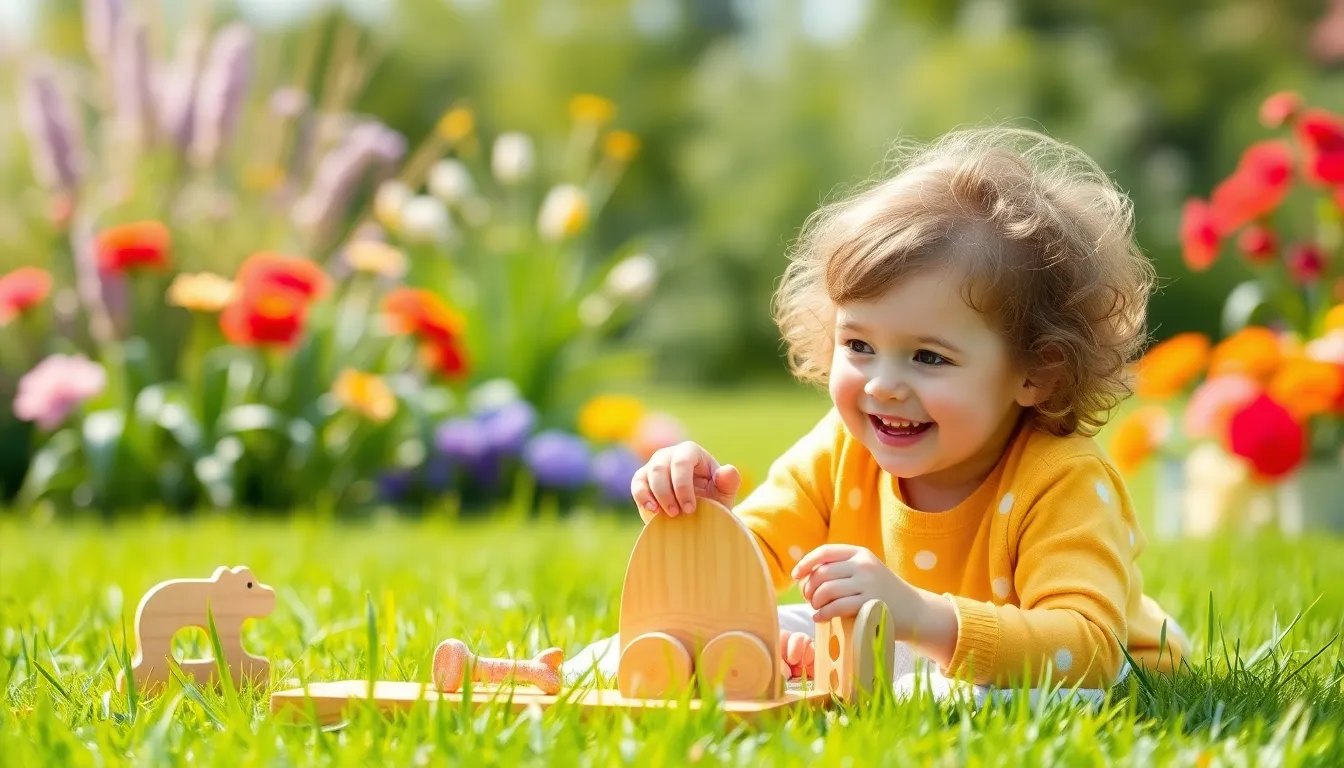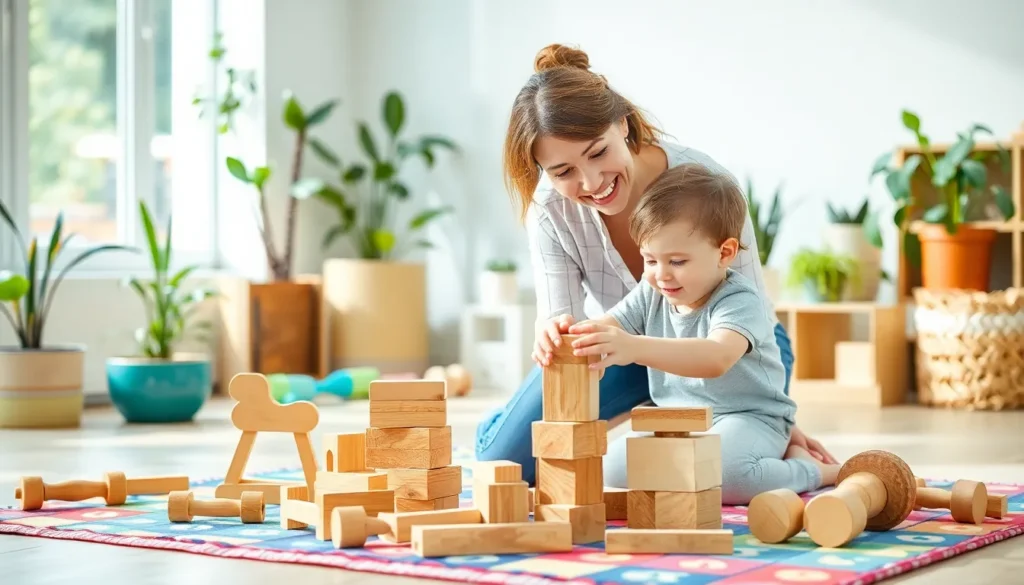Table of Contents
ToggleIn a world increasingly aware of environmental issues, the demand for sustainable products is on the rise. Parents are now seeking out environmentally friendly toys that not only entertain but also promote a healthier planet for future generations. These toys are crafted from sustainable materials, reducing plastic waste and fostering eco-consciousness in children.
Choosing eco-friendly toys goes beyond just making a responsible purchase. It’s about instilling values of sustainability and care for the environment in young minds. With a diverse range of options available, from wooden blocks to organic cotton stuffed animals, parents can find toys that align with their values while ensuring their kids have fun. Embracing these choices can lead to a brighter, greener future for all.
Overview of Environmentally Friendly Toys
Environmentally friendly toys represent a crucial shift in consumer choices, emphasizing sustainability and ecological consciousness. These toys are crafted from safe, biodegradable materials such as wood, natural rubber, organic cotton, and recycled plastics. By prioritizing these materials, manufacturers contribute to reducing plastic pollution and promoting a healthier planet.
Parents favor environmentally friendly toys for several reasons:
- Safety: Many eco-friendly toys lack harmful chemicals, making them safer for children.
- Durability: Sustainable toys often boast greater longevity, providing extended use and reducing the need for frequent replacements.
- Educational Value: These toys frequently incorporate educational aspects that promote awareness about sustainability and environmental stewardship.
A range of options exists for parents to choose from, including:
- Wooden Toys: Durable pieces like blocks and puzzles encourage creativity and motor skill development.
- Organic Stuffed Animals: Crafted from non-toxic materials, these provide comfort without synthetic chemicals.
- Recycled Playsets: Many constructions and figurines utilize recycled materials, merging fun with eco-friendly practices.
Selecting environmentally friendly toys not only safeguards children’s health but also nurtures a sense of responsibility towards nature. By fostering playtime with sustainable choices, parents effectively instill values of environmental care in their children.
Benefits of Choosing Eco-Friendly Toys

Choosing eco-friendly toys offers substantial benefits for both children and the environment. Parents increasingly recognize these advantages, making informed decisions about suitable options for their kids.
Health Benefits for Children
Choosing eco-friendly toys promotes health and safety for children. Most eco-friendly toys contain non-toxic materials, reducing exposure to harmful chemicals often found in conventional toys. Toy types such as wooden blocks and organic cotton stuffed animals avoid phthalates and BPA, minimizing allergy risks and skin irritations. Additionally, these toys are often sturdier, ensuring they withstand wear and tear, which means less likelihood of small parts breaking off and posing choking hazards.
Environmental Impact
Opting for eco-friendly toys significantly reduces environmental impact. Many eco-friendly toys are crafted from renewable resources, such as sustainably harvested wood or recycled plastic, lessening the demand for new materials. Production processes for these toys often consume less energy and generate fewer emissions compared to traditional toy manufacturing. Notably, biodegradable and compostable options ensure that once the toys reach the end of their life cycle, they return to the earth rather than contributing to landfill waste. This shift cultivates a sense of environmental responsibility in children, encouraging them to engage with sustainable practices as they grow.
Types of Environmentally Friendly Toys
Various types of environmentally friendly toys cater to different preferences and values. They primarily consist of toys crafted from natural and recycled materials, each offering unique benefits.
Natural Materials
Toys made from natural materials prioritize sustainability and safety. Commonly used materials include:
- Wood: Sourced from responsibly managed forests, wooden toys offer durability and timelessness. They often come in various forms, such as building blocks or educational puzzles, stimulating creativity and problem-solving skills.
- Natural Rubber: Harvested from rubber trees, natural rubber toys are both flexible and resilient. They often take the form of teething rings or balls, providing safe play options for infants and toddlers.
- Organic Cotton: Used in stuffed animals and soft toys, organic cotton ensures that no harmful pesticides or chemicals enter children’s play. These toys provide comfort while being safe for little ones.
Recycled Materials
Recycled materials play a crucial role in reducing waste and promoting sustainability. Key benefits include:
- Recycled Plastics: Toys constructed from post-consumer recycled plastics help divert waste from landfills. They can take the shape of playsets or action figures, allowing children to enjoy quality play while contributing to a cleaner environment.
- Recycled Cardboard: Toys made from recycled cardboard are lightweight and versatile. They often include building sets or creative arts and crafts kits, fostering imaginative play while being budget-friendly and eco-conscious.
These categories of environmentally friendly toys provide parents with numerous choices, aligning with their commitment to sustainability and the well-being of their children.
Popular Brands and Products
Several brands lead the way in offering environmentally friendly toys, each emphasizing sustainability while providing engaging options for children.
Brand A: Commitment to Sustainability
Brand A prioritizes eco-friendliness by utilizing sustainable materials throughout its product range. Offering toys made from responsibly sourced wood, organic cotton, and natural rubber, the brand ensures that each item adheres to strict safety standards. Transparency in sourcing is key, as Brand A provides detailed information about where materials come from, fostering trust with consumers. Parents appreciate the low environmental impact of these toys, which are crafted to last longer and reduce waste. The brand’s commitment extends beyond production, as they also engage in recycling initiatives and contribute to reforestation projects, reinforcing their dedication to a healthier planet.
Brand B: Innovative Designs
Brand B stands out through its innovative designs that captivate children while promoting environmental awareness. Their toys, made from recycled materials, feature vibrant colors and imaginative themes that inspire creativity. By blending fun functionality with sustainability, Brand B encourages children to develop problem-solving skills through play. The brand’s unique approach includes interactive elements that teach the importance of recycling and conservation. Parents recognize the educational value embedded in the designs, making it easier to integrate lessons about sustainability into everyday playtime experiences. With a focus on quality and design, Brand B remains a popular choice among eco-conscious families.
How to Choose Environmentally Friendly Toys
Choosing environmentally friendly toys involves careful consideration of various factors to ensure both safety and sustainability. Parents can make informed decisions by examining certifications and assessing age appropriateness.
Certifications to Look For
Selecting toys with recognized certifications assures parents of their safety and environmental impact. Look for certifications such as:
- ASTM International: Ensures toys meet safety standards for materials and construction.
- CPSIA Compliance: Confirms products adhere to the Consumer Product Safety Improvement Act, addressing hazardous substances.
- Forest Stewardship Council (FSC): Indicates wood sources are sustainably managed and environmentally sound.
- OEKO-TEX: Guarantees textiles are free from harmful substances, promoting safe play.
- Global Organic Textile Standard (GOTS): Validates that organic textiles maintain a high standard of environmental and social responsibility.
Toys bearing these certifications empower parents to trust their purchases and prioritize their children’s safety.
Age Appropriateness and Safety
Ensuring age appropriateness when choosing toys enhances children’s safety and developmental growth. Consider these factors:
- Age Recommendations: Check packaging for age guidelines to match toys with children’s developmental stages.
- Small Parts: Avoid toys with small components for children under three to reduce choking hazards.
- Material Safety: Choose toys made with non-toxic materials to minimize exposure to hazardous substances.
- Durability: Prioritize robust toys that endure rough play, decreasing the chance of breakage and injury.
By focusing on age appropriateness and safety features, parents foster a secure play environment while promoting eco-friendly choices.
Choosing environmentally friendly toys is a meaningful step towards nurturing both children’s play and the planet’s health. By opting for toys made from sustainable materials, parents instill values of responsibility and care for the environment in their children. These toys not only provide safe and engaging play experiences but also contribute to a sustainable future.
With a variety of options available, parents can find toys that align with their values while ensuring their kids have fun. As awareness of environmental issues continues to grow, selecting eco-friendly toys becomes more than just a choice; it’s a commitment to fostering a healthier world for future generations.




